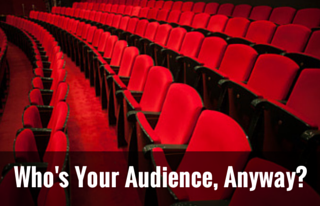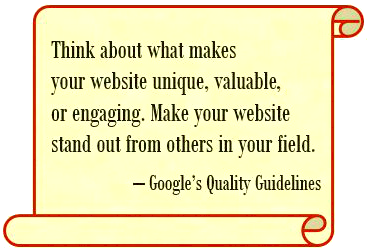Step 5: Key Considerations when Writing Content
As you research keywords, analyze competitors and so on, you’ve probably discovered your website’s real issue — you have insufficient or weak content.
It takes a lot of words to convince potential customers and the search engines that you are a subject matter expert. You need content that’s original and provides some unique, compelling benefit to users, whether that’s insight, research, tools, reviews, advice or a tutorial like this one.
How can you create web pages that work for users and search engine spiders alike? This SEO tutorial lesson gets you ready with the key considerations for writing content that hits the mark.
We’ll start with some crucial questions to consider before picking up the proverbial pen.
SEO Tip: Give this page to your copywriting team to help them write better quality content.
Know Your Audience

Job No. 1 when writing content is to attract and serve customers — the people who would want what your website offers. Your content must meet their expectations, grab their interest and lead them to whatever conversion goal the site has. So primarily write for people, not search engines.
You’d write differently for teenagers than you would for graduate students, family-focused homeowners, or retirees. Keeping your target audience in mind will help you know how to write SEO content that addresses their needs in their words and reaches them effectively.
So before you write, identify who’s your customer:
- What kinds of people are interested in my product/service/information?
- What are they looking for?
- What needs/questions would they have on my site?
- What communication style would feel natural to them?
- How can my site make them feel welcome?
- What would appeal to them and make them respond?
Know the Goal
Before writing any web page, blog post or article, have a clear goal in mind. Otherwise, you’re likely to write rambling text that isn’t relevant for anything. The goal shouldn’t be “to rank high for keyword XYZ.” Instead, always set a user-focused goal. For example, this page’s goal is to prepare web copywriters to write content that works for users and search engines.
Interestingly, search engine optimization often inspires content writing. For instance, your research may uncover a relevant keyword that your website doesn’t talk about yet. Or looking at competitors may spark an idea for a great infographic that’ll attract new visitors.
When you sit down to create those new pages, though, focus on the customer and make something useful. You can tweak and optimize your content for SEO later (as you’ll learn later in this SEO tutorial).
For search relevance, keep your copywriting focused on the goal and the page’s keyword subject. If you write a page about how to water ski, but half the text describes picnicking on the shore, your page’s relevance to water skiing gets diluted. The search engines (and possibly users) won’t know what your page is really about.
Make Quality Content
Quality is the name of the game in web marketing today. Search engines can detect what’s original and compelling versus spammy or duplicated content. In fact, Google even gives penalty warnings to sites that have “thin content with little or no added value.”
Users have advanced, too. People search with longer text queries (four to five words is the average) as well as conversational voice queries. They also have higher expectations of finding useful content.
So as search engine algorithms get better at determining users’ intent, websites must deliver quality if they want to compete for customers and search engine rankings.
SEO TUTORIAL BONUS
Watch this interview clip because in it you’ll learn why average or poor quality content, no matter how many pages you have, can actually harm your rankings.
Here, marketer and reporter Murray Newlands from Search Engine Journal picks Bruce Clay’s brain on the importance of quality content for SEO. They also discuss how to deal with ranking penalties resulting from low-quality content.
What Makes Quality Content?
To create quality content for your website, here’s a short checklist of dos and don’ts to keep in mind.
 Do:
Do:
- Write original, unique text.
- Use keywords in a way that reads naturally. (Remember, write for users!)
- Write for the way people read online, with shorter sentences and paragraphs.
- Use bulleted and numbered lists, which are easy for readers to scan.
- Include images, embedded videos and other engagement objects.
- Follow our guidelines for how to add keywords to your content (covered in the next step of this SEO tutorial).
Don’t:
- Overuse keywords (also known as “keyword stuffing”).
- Try to optimize for keywords that are unrelated to the website’s contents.
- Duplicate content pages.
- Hide text from users that shows to search engines (such as putting text on a same-color background).
- Try to deceive search engines in any way (known as “webspam“).
Summary of Key Considerations When Writing Content
- Write for your customers, not spiders.
- Have a goal for each page.
- Focus on your keyword subject.
- Make it interesting; make it useful.
- Go for quality.
OK! Now you’re ready to learn how to include keywords naturally for users — and effectively for SEO — when you’re writing content.
Related blog posts and articles:
10 Steps to Improve Your Content Strategy (and Your Marriage, If You’re Into That)
Avoiding Duplicate Content
The SEO Copywriter’s Checklist
Back to Basics: Creating Quality Content for the Web
SEO-Friendly Content Curation in a Post-Panda World

Want more help with content strategy and SEO? Bruce Clay teamed up with PR veteran Murray Newlands to write the book Content Marketing Strategies for Professionals.
Pick up your copy — available on Amazon.
<



